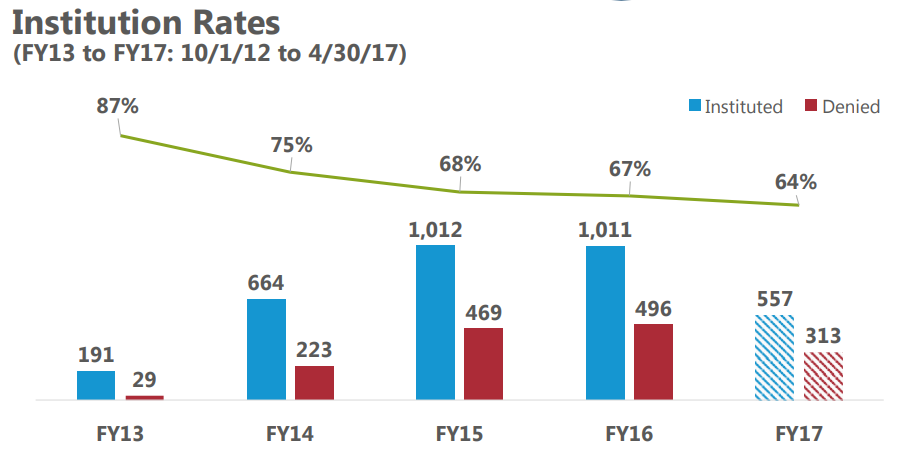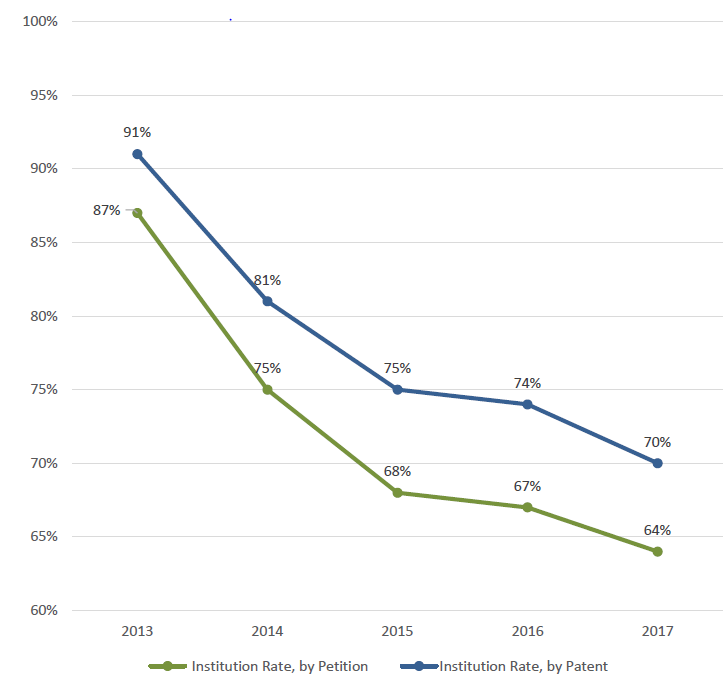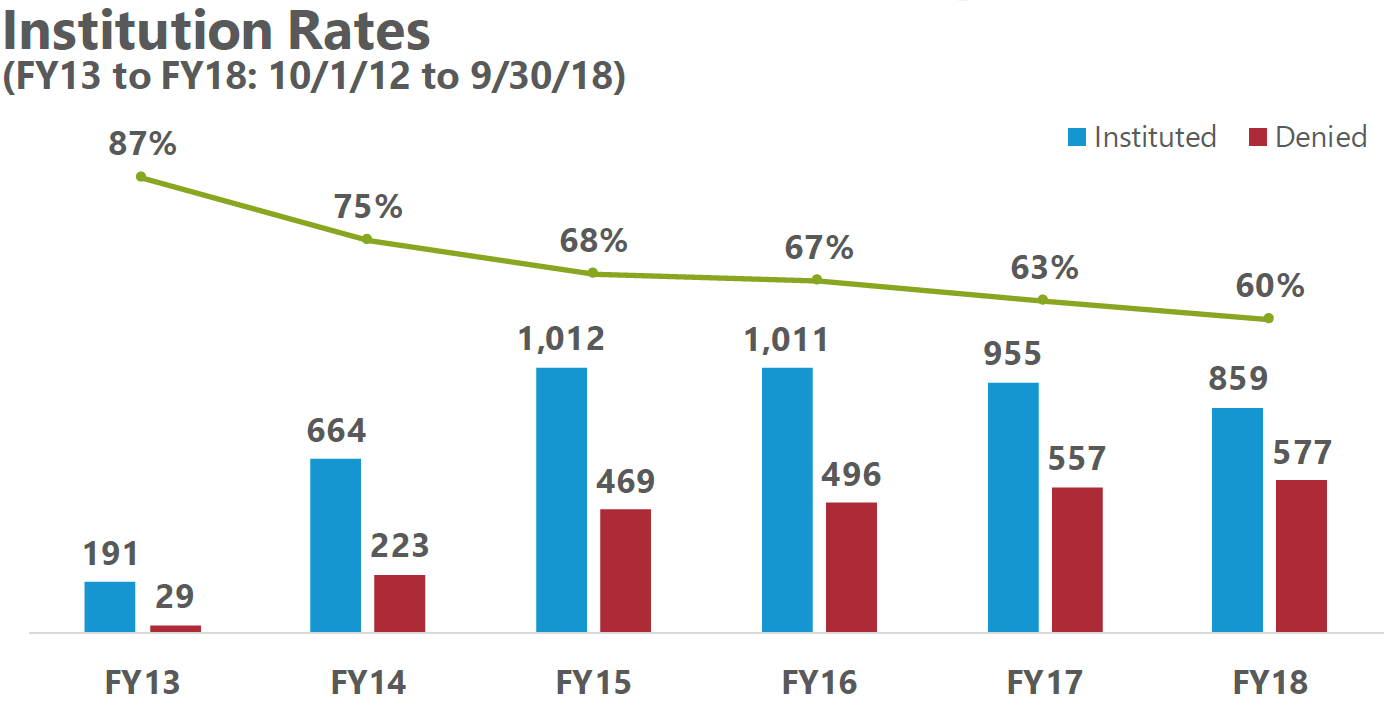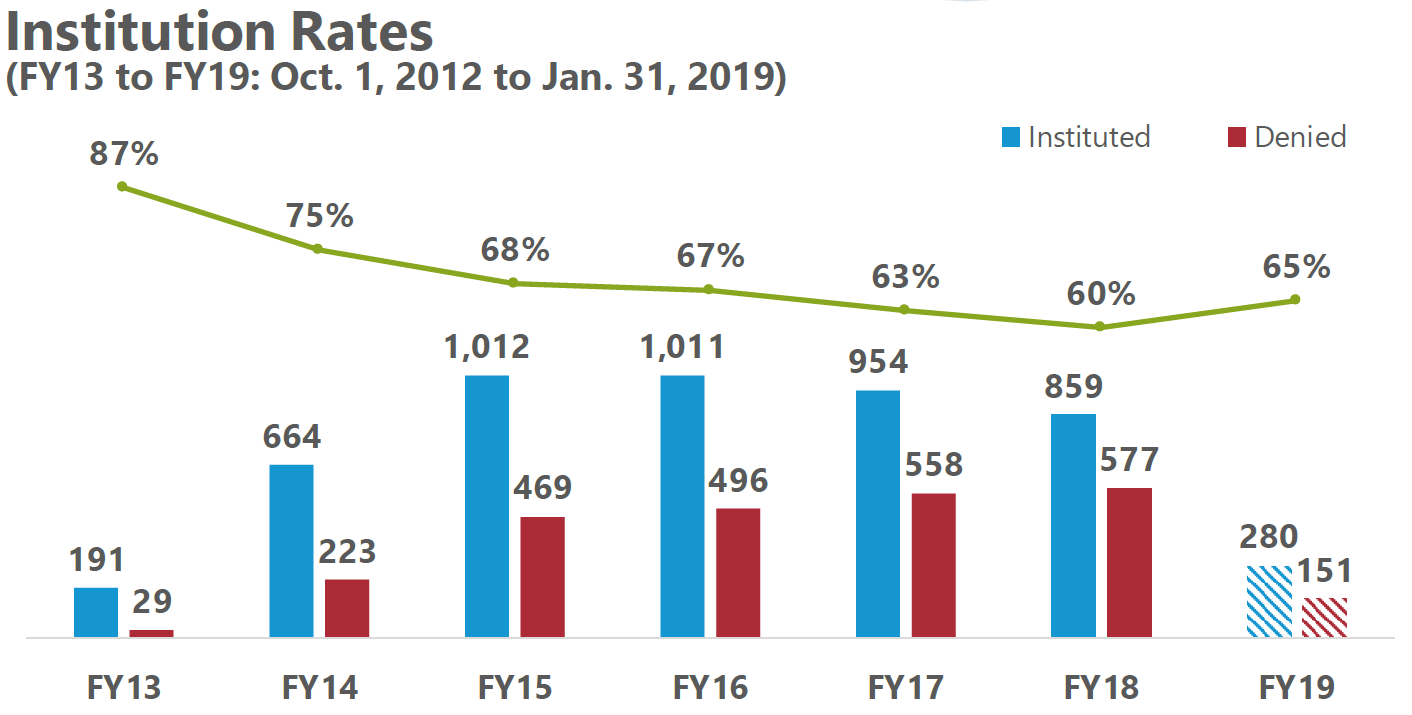By statute, Congress gave the Patent Trial and Appeal Board (“PTAB”) broad discretionary power in deciding whether or not to institute an inter partes review (“IPR”) proceeding.[1] Recently, the PTAB’s application of this discretionary authority to deny IPR petitions has continued to be aggressive in frequency and scope.
Several possible rationales for this continued upward trend exist including: (1) docket management, (2) concerns with protecting review process/patent owners from “abuse”, and (3) the SAS Institute Inc. v. Iancu decision.[2]
PTAB Docket Management
On docket management, frankly, the PTAB is a busy place and continues to get busier. For example, petitioners filed 1,613 total post-grant petitions in FY2018[3] and 596 petitions in the first three months of FY2019 alone[4]. With 1,486 active post-grant proceedings[5], and approximately 270 PTAB judges[6] split into three judge panels per proceeding, on average, a given panel has 17 active proceedings on its docket at any given time.
One important takeaway (that is also reiterated below) is that petitioners must be judicious about grounds and cognizant of the PTAB’s discretion to deny institution of IPR petitions based purely on the “limited” or “finite” resources of the Board.[7]
PTAB Expressed Concerns with Protecting Patent Owners from “Abuse”
On “abuse” concerns, since the middle of 2016, PTAB leadership has decidedly and publicly swung toward patent owners. For example, in his outgoing remarks in May 2016, the former PTAB Chief Judge Kelly stated there was “no bias against patents.”[8] And his successor (former PTAB Chief Judge Ruschke) was very vocal about the PTAB’s changing vision including by stating to reporters that it was “obvious that there are many concerns about potential unfairness to patent owners [in post-grant proceedings].”[9]
These public statements were not surprising to PTAB practitioners given the onslaught of negative publicity which often repeated and emphasized former Federal Circuit Chief Judge Rader’s labeling of the PTAB as a patent “death squad” in October 2013.[10] Many authors touted the initial PTAB institution rates (87% in 2013) as proof that this moniker was accurate.[11] This negative publicity carried internationally as well. For example, in February 2018, the U.S. fell to 12th in the Global Innovation Policy Center’s Worldwide IP Rankings with the accompanying report stating that “[t]he U.S. is no longer a global leader in this category of the Index. It is notably behind the top performers owing to uncertainty over patentability standards [i.e. 35 U.S.C. § 101] and a relatively low score for opposition proceedings [i.e. post-grant proceedings].”[12]
The PTAB leadership’s response to this negative publicity and shift toward patent owners was not mere lip service. In April 2017, the PTAB first began using the (now frequently used) “Institution Rates” chart which emphasized the declining institution rate trend: 87% in FY13 to 64% as of April in FY17 (reproduced below)[13]:
Around the same time, the PTAB also commissioned an internal “Multiple Petition Study” to address “fairness” concerns raised by patent owners.[14] And in the fall of 2017, the PTAB issued several forms of guidance on how the PTAB intended to use its discretionary power to address these concerns. For example, in September 2017, the PTAB Chief Judge expanded a panel in an IPR proceeding and issued the “precedential” General Plastic decision which laid out several factors which the PTAB could consider in deciding whether to deny a petition under its discretionary power codified at 35 U.S.C. § 314(a) and 37 C.F.R. § 42.108(a).[15] The following month, in a “Chat with the Chief” webinar[16], the Chief Judge detailed the results of the PTAB’s Multiple Petition Study, and explained how those results were memorialized in the “precedential” General Plastic decision factors, as well as in three “informative” decisions regarding the PTAB’s discretionary power under 35 U.S.C. § 325(d).[17]
During this October 2017 webinar, the Chief Judge emphasized that the PTAB is focused on follow-on petitions filed (1) against the same patent, (2) after, in an earlier-filed proceeding, a patent owner preliminary response was filed and/or a PTAB institution decision has issued, and (3) where the new petition does not also seek joinder[18] to the earlier-filed petition. In these circumstances, the PTAB’s stated belief is that the potential abuse/harassment of patent owners outweighs the PTAB’s mandate to eliminate bad patents. During this same webinar, the Chief Judge used the below chart to explain this belief and characterized the “By Patent” institution rate [blue] as being “only slightly higher” than the “By Petition” institution rate [green][19]:
In analyzing this chart, and the PTAB’s explanation, an obvious takeaway is that the PTAB is not interested in the 6-7% of patents that would otherwise be eliminated by post-grant proceedings if it means that a petitioner used the law of the case of prior proceedings involving that patent to eliminate it. And when comparing the data in this chart to the PTAB’s “Institution Rates” chart (April 2017 version reproduced above), another takeaway is that the PTAB does not want to achieve the top “By Patent” institution rate numbers (70%); rather the PTAB wants to achieve at least the bottom “By Petition” institution rate numbers (64%).
These same takeaways are evident from the former Chief Judge’s emphasis of the importance of several of the General Plastic factors[20] (summarized and highlighted in bold below) during this same webinar:
- Whether same petitioner, same claims, same patent?
- Whether Petitioner knew or should have known of prior art when original petition filed?
- Whether Patent Owner Preliminary Response and/or PTAB Institution Decision already filed?
- Filed soon after petitioner learned of prior art?
- Adequate explanation for time gap between petitions?
- Finite resources of Board
- Statutory requirement to issue Final Written Decision within 1 year of institution
In emphasizing the third factor, the PTAB affirmatively took the position that, unlike almost every other adjudicating body in the U.S., the PTAB will not permit petitioners to use the law of the case (e.g., its prior decisions or prior patent owner responses). Indeed, in multi-defendant cases in district court, different defendants are typically scheduled to go to trial one after the other and each defendant is permitted to put on its own invalidity defense. For example, district courts do not tell defendants, “Sorry, Company A already lost at trial on invalidity of those patent claims so you cannot challenge them in your trial.” But the PTAB considers use of the law of the case by petitioners to be unacceptably “abusive” toward patent owners. The PTAB memorialized these General Plastic factors in its August 2018 update to the Trial Practice Guide.[21]
The PTAB’s prohibition on petitioners using the law of the case expanded to co-defendants (and first-time filers) in September 2018 in Shenzhen Silver Star v. iRobot.[22] Here, the patent owner (iRobot Corp.) filed complaints in the International Trade Commission (“ITC”) and district court in April 2017 which alleged patent infringement against Shenzhen Silver Star (“Silver Star”), Shenzhen Zhiyi Technology Co., Ltd (“Zhiyi”), and others. Zhiyi filed the first IPR challenge to the asserted patent on September 8, 2017. After iRobot filed a preliminary response to that petition in December 2017, but prior to institution of the Zhiyi IPR, co-defendant Silver Star filed a second IPR petition challenging the patent on March 8, 2018.[23] The PTAB denied institution of the Zhiyi IPR on the merits on March 12, 2018, and despite Silver Star being a first-time filer, denied Silver Star’s IPR petition under its § 314(a) discretionary authority. In doing so, the PTAB stated that “[t]he timing of petitioner’s filing in this case raises the potential for abuse, because petitioner had ample opportunity (almost three months) to study the arguments raised by patent owner regarding the commonly challenged claims of the [patent].” In a concurring opinion, one of the PTAB judges even proposed an additional (8th) General Plastic factor: “Are petitioner and prior petitioner similarly situated defendants (similar-in-time hazard regarding the challenged patent)?”
PTAB panels have further expanded this prohibition to non-similarly situated co-defendants as illustrated in November 2018 in Nichia Corp. v. Document Security Sys., Inc.[24] In this case, the patent owner (DSS) sued Nichia eight months after it had previously sued Seoul Semiconductor and several days after Seoul had challenged the asserted patent in an IPR petition. Nichia filed its own IPR petition less than six months after being served with a complaint and prior to an institution decision in the Seoul IPR, but two-and-a-half months after DSS filed a preliminary response in the Seoul IPR. The PTAB instituted the Seoul IPR on June 7, 2018, but, despite Nichia being a first-time filer and a non-similarly situated co-defendant, denied Nichia’s IPR petition under its § 314(a) discretionary authority. In doing so, the PTAB identified that the “substantially similar application of the same prior art with additional citations [in Nichia’s IPR petition as compared to Seoul’s IPR petition] seems to suggest that [Nichia] benefitted from” the preliminary response in the Seoul IPR, and that Nichia “chose to file a single petition with substantial (but not complete) overlap with” the Seoul IPR.[25] The PTAB also noted that the petitioner had dedicated only three sentences in its petition to addressing the prior Seoul IPR petition and made no mention of the General Plastic decision or factors.[26]
In September 2018, the PTAB issued an updated “Institution Rates” chart which emphasized its continued declining institution rate trend: 87% in FY13 to 60% as of September 30, 2018 (reproduced below)[27]:
Impact of SAS v. Iancu Decision
Another possible rationale for the continuing upward trend toward aggressive application by the PTAB of its discretionary authority to deny IPR petitions is the U.S. Supreme Court’s SAS Institute Inc. v. Iancu decision.
Under this decision, and subsequent PTAB guidance, the PTAB must institute on all challenges in the petition or not institute at all (i.e., issue a binary decision).[28] In other words, after SAS, there are no longer either (1) partial IPR institutions based on claims, nor (2) partial IPR institutions based on grounds. As discussed above, PTAB docket management was already an issue prior to SAS, and the PTAB had already demonstrated and expressed its intent to maintain an institution rate that reflected “no bias against patents.” And, by its very nature and left unchecked by the PTAB, SAS would certainly start to increase these institution rates simply because the denial process (having to go through all claims, all grounds) is harder than the institution process (only need to find that petitioner had a reasonable likelihood of success in invalidating 1 claim on 1 ground[29]).
Shortly after the Supreme Court issued the SAS decision, the PTAB Chief Judge held two Chat with the Chief webinars on SAS.[30] During the June 5, 2018 webinar, the Chief Judge stated that, for already-instituted proceedings in which one or more grounds were denied under § 325(d) and the PTAB instituted on other grounds, the PTAB would issue a supplemental institution order instituting on all claims and on all grounds presented in the petition.[31] However, the Chief Judge also stated that the PTAB would evaluate not-yet instituted IPR petitions, and future-filed petitions, which include this identical combination of grounds, “on a case by case basis” and noted the PTAB’s power to exercise discretion and deny institution on all grounds per SAS.[32]
As anticipated following SAS, the PTAB’s Institution Rates chart issued as of January 31, 2019 showed an uptick in institution rates for fiscal year 2019 (from 60% in FY18 to 65% in FY19)[33]:
Takeaways from the Continuing Trend of PTAB Aggressively Using Its Discretionary Power to Deny Institution of Petitions
The PTAB certainly does not like the uptick in its institution rates and, as discussed above, has the discretionary authority and expressed commitment to offset this SAS trend. Thus, going forward, there are several takeaways for PTAB practitioners.
First, practitioners should expect the PTAB to continue to aggressively use its discretionary power to deny institution of petitions. Second, besides § 314(a) and § 3254(d), the PTAB can deny petitions based purely on the “limited” or “finite” resources of the Board including, for example, for (1) voluminous or excess grounds (even if split into multiple petitions) and (2) a petitioner’s failure to propose a construction of a term that would reasonably be construed as a means-plus-function term.[34]
Specifically relating to the continuing trend of the PTAB aggressively using its § 314(a) discretionary power, PTAB practitioners should also take away:
- The PTAB considers attempts to benefit from earlier patent owner filings and/or PTAB decisions in later-filed petitions as “abusive” to patent owners. This applies even to first-time filers.
- If filing a follow-on petition, the petitioner MUST include a General Plastic factor-by-factor analysis of facts in the petition (expect the PTAB to deny requests to file a preliminary reply to address these factors)
- A possible exception to a later-filed petition being considered “abusive” to a patent owner is where the later filing is a result of a patent owner’s “serial” lawsuit practice. In this case, the follow-on petitioner should emphasize these facts in its analysis of General Plastic factors 1, 2, 4, 5.[35]
- For co-defendants and joint defense groups: If considering challenging a patent at the PTAB, (1) file on or about the same time as other “similarly situated” petitioners (or consider joinder), (2) file BEFORE the patent owner preliminary response in the earlier-filed proceeding, (3) the one-year bar period goes out the window if another similarly situated defendant filed early in the case, and (4) weigh concerns associated with patent owner allegations relating to “real-parties-in-interest” and/or privity against reality that the first-time filer may be the only shot at invalidating a patent.
Specifically relating to the continuing trend of the PTAB aggressively using its § 325(d) discretionary power, PTAB practitioners should also take away:
- The PTAB considers attempts to re-argue earlier USPTO decisions and/or PTAB decisions in later-filed petition as “abusive” to patent owners. This applies even to first-time filers.
- If, in an IPR ground, a petitioner is considering relying on a reference which was previously considered by the USPTO during prosecution of the challenged patent or by the PTAB during a re-examination or a post-grant proceeding, the petitioner: (1) MUST include a Becton Dickinson factor-by-factor analysis of facts in the petition (expect the PTAB to deny requests to file a preliminary reply to address these factors), (2) include this analysis in the petition even if the ground is a combination of such a reference with a reference that was not before the USPTO or PTAB, and (3) must include new evidence and arguments related to the reference.
- SAS and § 325(d) considerations: If a petitioner is considering filing a petition with multiple grounds, and not all of the grounds rely on a USPTO or PTAB considered reference: (1) always remember the cardinal rule to be judicious about grounds, (2) consider filing separate petitions, and, if filing separate petitions (3) include the aforementioned Becton-Dickinson analysis in the petition with the prior considered reference, and (4) evaluate potentially applicable General Plastic factors in the other petition (e.g., factors 1, 2, 4, 5, and 6).
[1] See 35 U.S.C. §§ 314(a), 325(d); 37 C.F.R. §42.108(a); Harmonic Inc. v. Avid Tech, Inc., 815 F.3d 1356, 1367 (Fed. Cir. 2016) (“the PTO is permitted, but never compelled, to institute an IPR proceeding”) (emphasis added).
[2] SAS Institute Inc. v. Iancu, 138 S. Ct. 1348 (2018).
[3] PTAB Trial Statistics, September 2018, (available at https://www.uspto.gov/sites/default/files/documents/trial_statistics_20180930a.pdf.) 1,521 of these petitions were IPR petitions. Id.
[4] PTAB Trial Statistics, January 2019, (available at https://www.uspto.gov/sites/default/files/documents/trial_statistics_jan2019.pdf.) 555 of these petitions are IPR petitions. Id.
[5] Id. This number (as of January 31, 2019) does not include the 465 joined proceedings as of January 2019. Id.
[6] R. Davis, “PTAB Aims to Make AIA Reviews Fair to All, New Chief Says,” Law360, August 19, 2016.
[7] D.P. Ruschke, T. Fink, “Chat with the Chief”, June 5, 2018, slide 18 (“Challenges that Could Be Denied for Statutory Reasons”) (available at https://www.uspto.gov/sites/default/files/documents/chat_with_chief_june_6.5.18.pdf).
[8] T. Dutra, “Chief PTAB Judge Rejects Charge of Board Anti-Patent Bias,” Intellectual Property on Bloomberg Law, May 11, 2016.
[9] Id.
[10] See, e.g., R. Davis, “PTAB’s ‘Death Squad’ Label Not Totally Off-Base, Chief Says,” Law360, August 14, 2014; P.J. Pitts, “’Patent Death Squads’ vs. Innovation,” Wall Street Journal, June 10, 2015; S. Vermont, “IPR Statistics Revisited Yep, It’s A Killing Field,” PatentAttorney.com, February 8, 2017.
[11] Id.
[12] U.S. Chamber of Commerce, “Create: U.S. Chamber International IP Index,” 6th ed., February 2018, Figure XI, pp. 36-37 (available at: http://www.theglobalipcenter.com/wp-content/uploads/2018/02/GIPC_IP_Index_2018.pdf). This statistic was noted in the current United States Patent and Trademark Office (“USPTO”) Director’s testimony before the U.S. Senate Judiciary Committee. “Oversight of the U.S. Patent and Trademark Office” Before the U.S. Senate Judiciary Committee, April 18, 2018 (statement of Andrei Iancu) at 4 (available at https://www.judiciary.senate.gov/imo/media/doc/04-18-18%20Iancu%20Testimony.pdf.)
[13] PTAB Trial Statistics, April 2017, (available at https://www.uspto.gov/sites/default/files/documents/aia_statistics_april2017.pdf.)
[14] D.P. Ruschke, W.V. Saindon, “Chat with the Chief: An Analysis of Multiple Petitions in AIA Trials”, October 24, 2017, (available at https://www.uspto.gov/sites/default/files/documents/Chat_with_the_Chief_Boardside_Chat_Multiple_Petition_Study_20171024.pdf.)
[15] General Plastic Industrial Co., Ltd. v. Canon Kabushiki Kaisha, IPR2016-01357, Paper 19 (Sept. 6, 2017) (slip. op.) (precedential); 35 U.S.C. § 314(a) (“The Director may not authorize an inter partes review to be instituted unless the Director determines that the information presented in the petition filed under section 311 and any response filed under section 313 shows that there is a reasonable likelihood that the petitioner would prevail with respect to at least 1 of the claims challenged in the petition.”) (emphasis added); 37 C.F.R. § 42.108(a) (“When instituting inter partes review, the Board may authorize the review to proceed on all or some of the challenged claims and on all or some of the grounds of unpatentability asserted for each claim.”) (emphasis added).
[16] D.P. Ruschke, W.V. Saindon, “Chat with the Chief: An Analysis of Multiple Petitions in AIA Trials”, October 24, 2017, (available at https://www.uspto.gov/sites/default/files/documents/Chat_with_the_Chief_Boardside_Chat_Multiple_Petition_Study_20171024.pdf.)
[17] Unified Patents, Inc. v. Berman, IPR2016-01571, Paper 10 (PTAB Dec. 14, 2016) (slip. op.); Hospira, Inc. v. Genentech, IPR2017-00739, Paper 16 (PTAB July 27, 2017) (slip. op.); Cultec, Inc. v. Stormtech LLC, IPR2017-00777, Paper 7 (Aug. 22, 2017) (slip. op.). In April 2018, the PTAB identified two additional “informative” decisions regarding the PTAB’s discretionary power under 35 U.S.C. § 325(d): Kayak Software v. IBM, CBM2016-00075, Paper 16 (PTAB Dec. 15, 2016) (slip. op.) and Becton Dickinson v. B. Braun, IPR2017-01586, Paper 8 (PTAB Dec. 15, 2017) (slip. op.). In its Becton Dickinson decision, the PTAB identified six “non-exclusive” factors for determining whether to deny a petition under § 325(d). Becton Dickinson, IPR2017-01586, Paper 8, at 17-18.
[18] See 37 C.F.R. § 42.122.
[19] D.P. Ruschke, W.V. Saindon, “Chat with the Chief: An Analysis of Multiple Petitions in AIA Trials”, October 24, 2017, (available at https://www.uspto.gov/sites/default/files/documents/Chat_with_the_Chief_Boardside_Chat_Multiple_Petition_Study_20171024.pdf.) “By Patent” accounted for whether any one petition against a particular patent was instituted and “By Petition” accounted for whether a particular petition was instituted. Id.
[20] It is important to note that the General Plastic decision and its progeny do not require that all of these factors be considered nor does it require a balancing test; rather, a PTAB panel could focus on one of the factors and deny institution under its § 314(a) discretionary power. See, e.g., Thermo Fisher Scientific, Inc. v. Regents of the Univ. of California, IPR2018-01369, Paper No. 12 at (PTAB, Feb. 7, 2019) (slip. op.) (PTAB denied institution of IPR filed right before one-year bar date and ten months before district court trial date under §314(a) and General Plastic as institution would be “an inefficient use of the Board’s resources.”)
[21] “Trial Practice Guide Update”, 83 FR 39989, at 8-11 (USPTO August 13, 2018) (available at: https://www.uspto.gov/sites/default/files/documents/2018_Revised_Trial_Practice_Guide.pdf. The PTAB also memorialized the Becton Dickinson factors in this same update. Id. at 12-13.
[22] Shenzhen Silver Star Intelligent Tech. v. iRobot Corp., IPR2018-00761, Paper 15, at 20-22 (PTAB, Sept. 5, 2018) (slip. op.)
[23] Thus, Silver Star filed its first IPR petition against the asserted patent 11 months after iRobot filed its complaint and six months after Zhiyi filed its IPR petition.
[24] IPR2018-01167, Paper 10, (PTAB Nov. 30, 2018).
[25] The PTAB identified that Nichia “included challenges based on prior art and two claims not challenged in [the Seoul IPR]” which “comprise about twenty-five percent of the [Nichia IPR] Petition.” Nichia, IPR2018-01167, Paper 10, at 24.
[26] Nichia, IPR2018-01167, Paper 10, at 23-24. Although the PTAB is the Wild West, with the makeup of the deciding panel sometimes being determinative of institution decision outcomes (especially those based on procedural, jurisdictional, and discretionary issues), Nichia’s minimalistic treatment of the prior IPR in its petition, and substantial similarity between the two petitions, appear to be important facts. For example, a different PTAB panel recently rejected a serially litigious patent owner’s request to have the panel deny institution of an IPR petition under § 314(a) where the asserted grounds were different between the two petitions, and the second petitioner identified in its petition that the “previous Petitioner did not have ‘any direction or control over the selection of prior art, the drafting of this [P]etition and supporting materials, or review of the [P]etition and supporting materials prior to its filing.’” Toshiba America Info. Sys., Inc. v. Walletex Microelectronics Ltd., IPR2018-01538, Paper 11, 19-23 (PTAB Mar. 5, 2019).
[27] PTAB Trial Statistics, September 2018, (available at https://www.uspto.gov/sites/default/files/documents/trial_statistics_20180930a.pdf.)
[28] SAS Institute Inc. v. Iancu, 138 S. Ct. 1348 (2018); Oil States Energy Services, LLC v. Greene’s Energy Group, LLC, 138 S. Ct. 1365 (2018); Guidance on the Impact of SAS on AIA Trial Proceedings, April 24, 2018, available at (https://www.uspto.gov/sites/default/files/documents/guidance_on_the_impact_of_sas_on_aia_trial_proceedings_%20(april_26,_2018).pdf).
[29] Seoul Semiconductor Co., Ltd. v. Document Security Systems, Inc., IPR2018-00265, Paper 24 (PTAB Oct. 1, 2018) (slip op.), pp. 3-4.
[30] D. Ruschke, T. Fink, S. Weidenfeller, “Chat with the Chief on SAS”, April 30, 2018, (available at https://www.uspto.gov/sites/default/files/documents/chat_with_chief_sas_5.3.18.pdf); D. Ruschke, T. Fink, “Chat with the Chief”, June 5, 2018, (available at https://www.uspto.gov/sites/default/files/documents/chat_with_chief_june_6.5.18.pdf.)
[31] Ruschke, T. Fink, “Chat with the Chief”, June 5, 2018, slides 15-18, (available at https://www.uspto.gov/sites/default/files/documents/chat_with_chief_june_6.5.18.pdf.)
[32] Id.
[33] PTAB Trial Statistics, January 2019, (available at https://www.uspto.gov/sites/default/files/documents/trial_statistics_jan2019.pdf.)
[34] Ruschke, T. Fink, “Chat with the Chief”, June 5, 2018, slide 18, (available at https://www.uspto.gov/sites/default/files/documents/chat_with_chief_june_6.5.18.pdf.)
[35] Toshiba America, IPR2018-01538, Paper 11, 21-22 (“Patent Owner’s complaint about the multiple inter partes review petitions filed against the [challenged] patent is not persuasive when the volume appears to be a direct result of its own litigation activity.”); Cf. Nichia, IPR2018-01167, Paper 10, at 18-19 (despite follow-on petitioner being sued after the 1st IPR petition was filed, PTAB denied institution where follow-on petitioner failed to address General Plastic factors in its petition and did not request an opportunity to reply to the patent’s owner’s General Plastic contentions in its preliminary response.)




